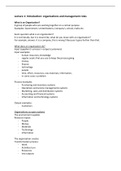Lecture 1: Introduction: organizations and management roles
What is an Organization?
A group of people who are working together on a certain purpose.
Examples: Government, United Nations, Company’s, school, mafia etc.
Exam question what is an organization?
It is not literally, but it is meant like, what do you mean with an organization?
For example, answer: it is a company, this is wrong!! Because it goes further than that.
What does an organization do?
Input (suppliers) > process > output (customers)
Input examples:
- human resources, knowledge
- regular assets that you use to keep the process going
- money
- finance
- technology
- people
- time, effort, resources, raw materials, information,
- in some cases a problem
Process examples:
- Purchasing and inventory systems
- Operations and service managements systems
- Marketing, sales and distribution systems
- Accounting and financial systems
- Information and technology systems
Output examples:
- Customers
Organizations as open systems
The environment supplies
Resource inputs:
- People
- Money
- Materials
- Technology
- Information
The organization creates
Transformation process:
- Work
- Activities turn
- Resources
- Into outputs
,The environment consumes
Product outputs:
- Finished goods and services
Sometimes the feedback you get from your outputs (customers) can change your inputs.
For example, if your customer wants more sustainable products, than you have to change
where your materials are from.
Profit and non-profit organizations
Profit organizations:
- Loreal
- LG
- Hugo Boss
Non-profit organizations:
- WWF
- UNICEF
- The government
The role of a manager
Organizer responsible for the results or for organizing that results are achieved, a manager
helps him or her employees to improve their skills (kind of a coach) etcetera. The role of a
manager is very broad.
Advisor, coach, mentor, role model, leader etc.
The challenges of a managerial role
Challenge 1: Performing through others
All the people you are performing to, have their own interests, hopes, passions, frustrations,
fears, anxieties etc.
You as a manager need to have an influence on these people and you have to inspire them.
There is a boss type of a manager and a leader type of a manager.
What are the skills a manager needs to have to be successful?
Patience, decision making, flexibility, communicative, respect, culture awareness etc.
Challenge 2: The complexity of organizations
- The decisions and actions of individuals and groups affect each other, and can have
multiple repercussions throughout the organization
- The ‘double multiplicity’ of management:
o One decision > multiple consequences
o Multiple actions > one goal
- Managers need to choose the right coordinated interventions to steer the system in
the right direction
, The complexity levels a manager has to deal with
People
- Thoughts
- Interests
- Feelings
- Motivations
- Skills
Organization
- Systems
- Culture
- Structure
- Routines
- Relationships
Micro environment
- Banks
- Suppliers
- Competitors
- Substitutes
- Customers
- Investors
Macro environment
- Socio-demographic developments
- Political-legal factors
- Economic situation
- Technological developments
- Environmental factors
Challenge 3: There’s a changing world outside
- New technologies
- Changing customer needs
- Social acceleration (when it comes to social media)
Organizations must adapt to a constantly changing environment.
(For example, Nokia, BlackBerry didn’t adapt).
Seeing the whole picture
What should a manager do then?
Reduction
How to reduce, what is the essence of the situation, what is the most important element and
how can you build connections between the different element that’s going on.
Helicopter view
Seeing a problem in its overall context, while still being able to attend the details if necessary
Recognize trade-offs and be willing to decide on priorities
‘If you choose one side, what is the cost of the other side?’





